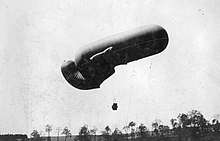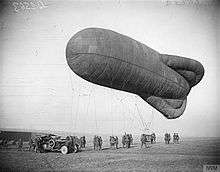Kite balloon
A kite balloon is a tethered balloon which is aerodynamically optimised for windy conditions by making it directionally stable and by minimising aerodynamic resistance to the wind, or drag. It typically comprises a streamlined envelope with stabilising features and a harness or yoke connecting it to the main tether.


Kite balloons are able to fly in higher winds than ordinary round balloons. They were extensively used for naval and military observation during World War I, and for anti-aircraft deployments as barrage balloons in World War II.
Development and construction
Developed in Germany from 1893 by Parseval and Sigsfeld, the main component of a kite balloon is its aerodynamically streamlined envelope, similar to that of a non-rigid airship. Unlike most airships, the envelope is also the main lifting gas bag. Types such as the German Parseval Drachen and French Caquot used wind pressure to inflate one or more stabilising ballonets at the rear, which acted as tail fins. A yoke or harness connected the balloon to the tether and was arranged to aid stability.[1][2]
Naval use
During the Atlantic U-boat campaign of World War I, kite balloons would be deployed by a destroyer escorting a convoy of merchant ships. A basket suspended below the kite balloon held a pilot who watched for U-boats and notified the destroyer of his observations by telephone via the insulated core of the kite balloon tether cable. The elevated balloon pilot had a clearer view of a submerged U-boat than was available from shipboard locations; and the kite balloon pilot could notify the ship of the U-boat's evasive maneuvers during a depth charge attack.[3]
Effectiveness
The availability of an elevated visual observation platform significantly enhanced the success of destroyers in finding and attacking U-boats prior to the invention of sonar. Convoys might have been better protected if every destroyer had been equipped with a kite balloon; but there was a limited number of balloons, and even fewer pilots qualified to fly in them. The United States Navy established an emergency balloon pilot training program in October, 1917, at Goodyear Tire and Rubber Company's Wingfoot Field in Akron, Ohio.[3]
The kite balloon pilot had a parachute in a flat container attached to the observation basket suspended from the kite balloon, with the pilot only wearing a simple body harness around his waist, with shroud lines from the harness attached to the main parachute in the container. When the balloonist jumped, the main part of the parachute was pulled from the container, with the shroud lines first, followed by the main canopy.[4] A similar parachute system for the entire observation basket was tested at Rockaway Naval Air Station, but it was not widely used.[3]
Operation
Each destroyer would secure the tether of an inflated kite balloon from the air station dock just prior to leaving port. While the destroyer escorted a convoy, the pilot would board the kite balloon basket each morning just before daylight. The pilot would clip the boarding line to his parachute harness so four seamen could hoist him into the balloon by pulling the opposite end of the line through a pulley on the kite balloon. They tried to make the hoist during a calm period, but it was not unusual for the pilot to be dunked into the Atlantic before reaching his observation basket. The kite balloon might behave erratically in the turbulence abaft the destroyer, so the whole observation basket might also be dunked before the tether was extended allowing the kite balloon to go aloft. Wet or dry, the balloon pilot spent the whole day aloft in the kite balloon whose appearance and airborne movement earned it the nickname: rubber cow.[3]
Returning from the kite balloon to the ship at the end of a long day was a reverse of the boarding procedure with the added risks of darkness and weariness. The only United States naval kite balloon pilot casualty was an unsuccessful attempted return to a destroyer escorting an eastbound convoy through the Irish Sea on the stormy evening of 14 August 1918. The rubber cow began alternately plunging port and starboard as the tether was shortened, dipping the pilot's basket into the water on each dive; and the basket was empty when the kite balloon stabilized on a short tether.[3]
See also
References
Notes
- Ege (1973).
- Vivian, Evelyn Charles; A History of Aeronautics, Collins 1921, Part III, Chapter VII, "Kite Balloons".
- Morse, Alan L. (1984). "Flying the Rubber Cows". Proceedings. United States Naval Institute. 110 (2): 74&75.
- "Observation Balloons On The Western Front". The Western Front Association. 29 June 2008.
Bibliography
- Brook, Dr. Peter; Koehler, R. B. & Woodman, Harry (2001). "Question 11/00: Russian Shipboard Balloons at Vladivostok in 1905". Warship International. International Naval Research Organization. XXXVIII (2): 131–136. ISSN 0043-0374.
- Ege, L.; Balloons and Airships, Blandford, London, 1973.